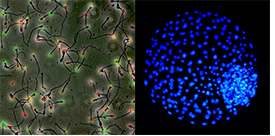The technologies we are developing to improve reproductive efficiency in cattle involve sperm evaluation and efficient production/selection of fertilized eggs (embryos), which will contribute to increase the number of cattle. The key for achieving this is to focus on the efficient production and/or selection of embryos only with a high chance of fertility. One of the important aims of our sperm evaluation technology is to predict fertility, especially by screening out semen of bulls with a high risk of infertility, utilizing various evaluation data of sperm such as epigenomic information and motility. In order to increase the number of oocytes (the 'source' of eggs) available for embryo production, we are developing a technology to produce embryos from the oocytes still growing within the secondary follicles in the ovary. A long-term culture of oocytes and in vitro fertilization is necessary to achieve this aim; we are applying a successful culture system which we have established for mouse oocytes to bovine oocytes. In addition, culture medium for embryos is also our target to be improved toward equipping embryos with sufficient developmental competence with the use of conditioned medium from oviduct cells. We have confirmed the improvement of quality of embryos after growth in the conditioned medium (patent pending).
In this way, we aim to provide new technology for expanding utilization of valuable embryos (in particular, Japanese Black cattle) through embryo transfer to dairy cows to maximize efficiency in beef cattle production.

(Left) Bull spermatozoa stained with FITC-PNA and PI.
Dead spermatozoa show red fluorescence (PI-positive), and spermatozoa with a reacted or damaged acrosome show green fluorescence (FITC-PNA-positive).
(Right) A bovine embryo obtained 7 days after insemination.
Hoechst 33342 staining (blue fluorescence) shows cell nuclei.




